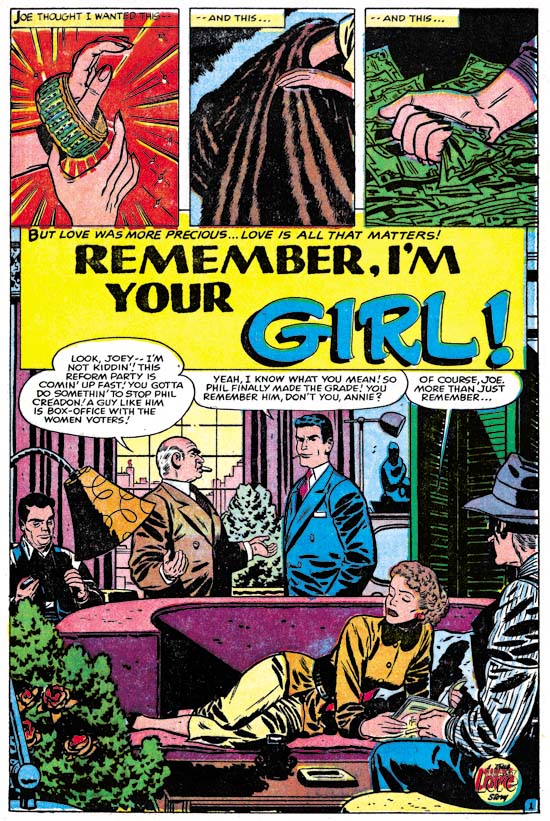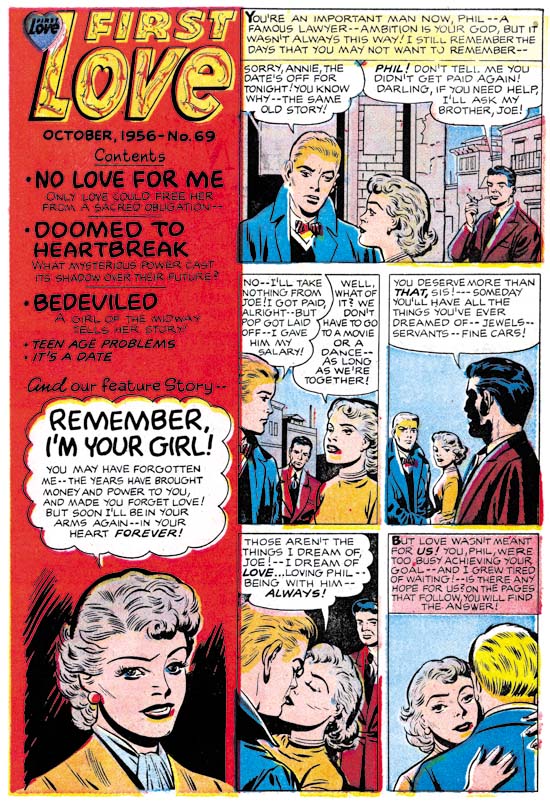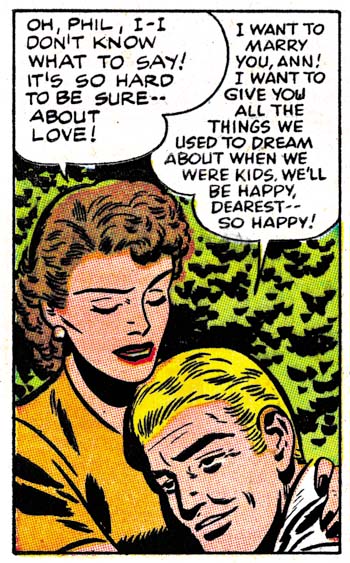
First Love #69 (October 1956) “Remember, I’m Your Girl”, page 1, pencils and inks by Bill Draut
With the period having 1956 cover dates Kirby was pretty much the only artist working on the Prize romance titles (Young Romance, Young Love and Young Brides). During this time Bill Draut and John Prentice who had previously been doing work for those titles began to appear regularly in the Harvey romance books instead. “Remember, I’m Your Girl” is typical of the work Draut did for Harvey. Bill still had an distinct style particularly characterized by simple but prominent eyebrows.
This a story about a man (Joe), his sister (Annie), and a former friend (Phil). Joe is now a successful politician and his sister is enjoying the financial fruits of that success. There is an approaching election and his position is being threatened by Phil, a rival candidate. Years before all three were good friends so Joe asks Annie to reconnect with Phil in order to find some weakness. His sister refuses but runs into Phil by accident and a romance develops. Joe wins the election but the sister continues her romance. When Joe confronts Annie to choose between her previous financial rewards or the rival, she chooses Phil.

First Love #69 (October 1956) contents page, pencils by Jack Kirby and Joe Simon, inks by Joe Simon?
Joe Simon was probably working for Harvey as an editor at this time. I generally do not consider works such as “Remember, I’m Your Girl” as Simon and Kirby productions. The format and length match Harvey romance stories from well before Joe’s time as Harvey editor. However something unusual happened in FL #68 and FL #69. Generally Harvey romances has a content page with at most a portion of the splash for each story. In FL #68 and #69 the content pages had a short original art that served as an introduction to the featured story.
For First Love #69 the feature story was Bill Draut’s “Remember, I’m Your Girl”. The same characters that appear in the feature story are presented here. The text makes it clear that the trio are shown in the earlier days while they were all still friends. A casual glance at the introduction story could result in attributing it to Bill as well. What particularly stands out are the simple but prominent eyebrows, which as I said was a Draut trait. A close examination reveals that the faces are not quite like Draut would do them, particularly in the story panels. There is not much to go but the spot inking does not look like Draut’s either. But I do not think it is just the case of some other artist inking Draut’s pencils. The layouts in the introduction story are not quite like Bill’s.
It is the layouts that provide a suggestion who the real artist was. In the first panel Joe is shown lighting up a cigarette. This is a typical Kirby theme and pose. In panels 2 to 4 the main speakers are placed in the front while those not speaking are placed in the background. This is a typical Kirby layout. Even the way Annie looks over Phil’s shoulder as they embrace is a typical Kirby pose. Although the artist tried to draw the characters like Bill Draut did he really could not completely adopt Bill’s more stylized pencils. Keeping in mind that he is imitating Draut, a close look at the faces suggests Kirby was the penciler.

First Love #69 (October 1956) “Remember, I’m Your Girl”, page 4 panel 1, pencils and inks by Bill Draut
In the past I have often warned about using some Kirby-esque features for attributing a work to Jack. Joe Simon was also familiar with Kirby’s techniques and was pretty good at mimicking most of them. If you ignore the attempt to copy Draut’s style, the number of Kirby-isms seems rather high even for Joe. But look at the drawing of Annie that appears in the bottom of the contents panel. It appears to be the done by yet another artist. A search of the actual story shows that the contents drawing was swiped the first panel of page 4. It would seem to be a reasonable deduction that Joe Simon did the contents drawing. If that is true then he was not have been responsible for the penciling of the introduction story.
The possibility of Kirby ghosting another artist was brought up recently by Bob H. in a comment to All-Star Western #99. I do not know if what Jack did for FL #69 introduction story would properly be called ghosting. It was not a case of fooling the editor, Joe was also involved in copying Draut on the content page. Nor was Draut a regular artist recognized by the reading public. Harvey romances are all unsigned and the artist used for the feature story would change. This was just a case of trying to maintain visual continuity between the contents page and the feature story. Imitating another artist was not something Jack did very often. Although his Draut was not perfect, it was good enough to fool many.


Hi Harry,
Nice detective work! The architecture in the first panel of the intro page also shouts out Kirby.
This brings me to something I sent last post that was never received. I agree that the S/K studio probably shut down after the last of the Mainline/Charlton stories. Yet for the next year, Kirby only did work either for Joe, or with Joe.
Do you think that there was still a partnership, or do you think that they had seperated but the only work Jack could find was with Joe. While some of the work certainly looks like solo Kirby, others, like the Harvey Western Tales stories seem so S/K-ish.
Also, it has been said that the Challs was originally pitched to DC as a Simon and Kirby vehicle.
My opinion is that there was still a partnership that was slowly winding down until it reached a point where it was no longer viable for Kirby to depend solely on Simon for finding work, and then, when Joe took on an editorial job, Jack had gotten the DC gig, and was comfortable being on his own.
Stan
Hi Harry,
>In FL #68 and #69 the content pages had a short original art that served as an introduction to the featured story.
Stan,
Yes I believe they were some sort of partnership after the end of Mainline/Charlton line of S&K. As you point out Joe seemed involved in all the work that Jack did before freelancing. Even after Jack started freelancing they pair still seemed to have some sort of special relationship. When Joe did Alarming Tales and Black Cat Mystic late in 1957, Jack was there to provide material. Also Race for the Moon in 1958. Jack continued to do art for Young Romance up to the end of 1959. Although done outside of a common studio, these could still be called Simon and Kirby productions. I suspect if any of them were really successful the old collaboration would have resumed.
A very different relationship between the two is evident, in my opinion, with the Archie Fly and Shield that started in 1959. Jack’s work for Young Romance ended with the start of 1960 and Joe became listed as the sole YR editor.
You seem to be having problems with your post getting cut off. I will say that I should be posting on FL #68 next week and FL #70 the week after.
Harry
Hi Harry,
I think the truncating problem occurs when I cut and paste a quote from your posting first. It seems nothing after the quote comes thru. What I was saying in response #2 was that this contents page also serving as a prelude to a story is found in some of the Harvey fantasy titles edited by Joe.. He seems to have been experimenting with this formatting at both Prize and Harvey.
I agree that by the time of the Fly and Shield there had been a complete severance of the official partnership.
Have you ever found anything at Joe’s referring to the legal partnership and its ending?
Stan
Stan,
Well that will teach you to quote me!
I do not think Joe has much, if anything, of business stuff from the period. He did show me the stock certificate for Mainline. Shows Joe as president and Jack as treasurer. Dated September 20, 1954. Which is a little funny since Bullseye #1 is cover dated August. Since work begins with a calender date 5 to 6 months before the cover date, that means the stock was issued some time after the company was already producing stuff. An image of the stock was used the recent Vanguard editions of “The Comic Book Makers”.
Harry